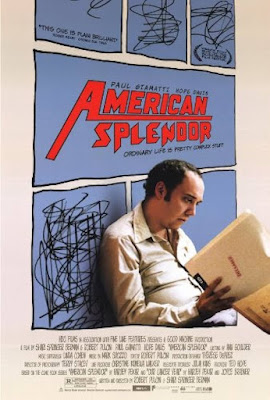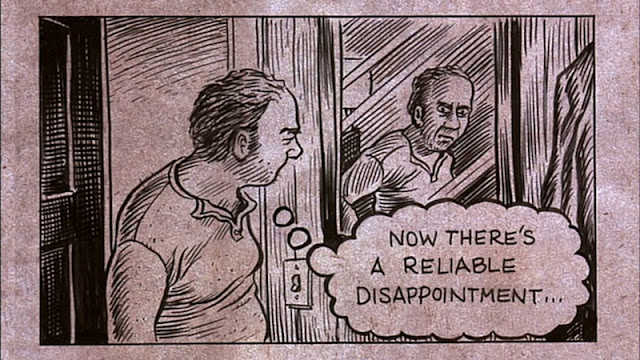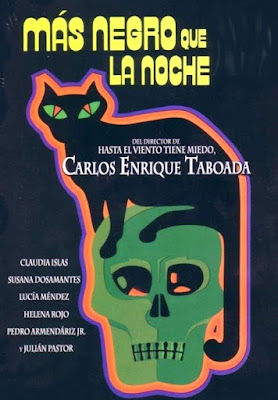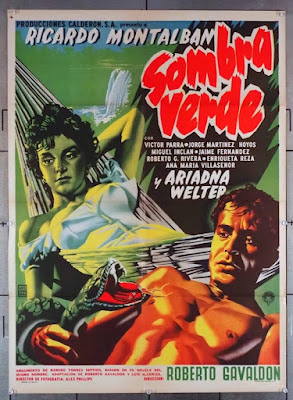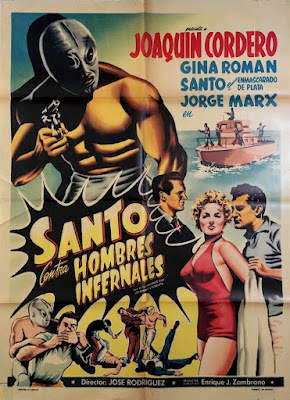(2003) Directed by Shari Springer Berman and Robert Pulcini; Written by Harvey Pekar, Joyce Brabner and Shari Springer Berman; Starring: Paul Giamatti, Shari Springer Berman, Harvey Pekar, Hope Davis, Joyce Brabner, Shari Springer Berman, Judah Friedlander, Toby Radloff, Earl Billings and James Urbaniak; Available on Blu-ray and DVD
Rating: ****½
“Okay, this guy here, he’s our man. All grown up and going
nowhere. Always a pretty scholarly cat. He never got much of a formal
education. For the most part, he’s lived in shit neighborhoods, held shit jobs,
and is now knee-deep in a disastrous second marriage. So, if you’re the kind of
person looking for romance or escapism or some fantasy figure to save the day,
guess what? You got the wrong movie.” – Harvey Pekar
Life is messy. It can’t be contained in the panels of a
comic book page, depicted in two dimensions, or condensed into thought bubbles.
Between its many ups and downs, there’s a bunch of monotonous stuff in the
middle. There’s no swift resolution to our conflicts like a 30-minute sitcom
episode, nor is there a superhero descending from the skies to set things
right. Underground comic writer Harvey Pekar instinctively understood this when
he set out to write American Splendor, chronicling his everyday exploits
as an ordinary file clerk, working in a Cleveland veterans’ hospital. Sure, it
didn’t have quite the pizzazz of Batman, Fantastic Four, or some other
fantasy-oriented comic, but it possessed something that none of those comics had
– relatability. Directors Shari Springer Berman and Robert Pulcini set out to
show us the story behind the story about Pekar’s life. The result is part
fiction, part fact, narrated by Mr. Pekar himself (who also appears with many
of the real-life people who became the subject of his comics).
Paul Giamatti, in the unexpected role of a lifetime, plays Harvey Pekar, full-time file clerk at Cleveland Veterans Hospital, part-time comic book writer and jazz critic. While Pekar appeared to be a misanthropic curmudgeon to most of the world, Giamatti’s insightful, sympathetic performance proves his character to be much more. Beneath Pekar’s gruff exterior is an intelligent, multi-faceted individual – angry yet sensitive, caustic yet vulnerable. His holistic approach captures Pekar’s specific gait, mannerisms, and facial expressions, conveying a perennial mixture of disgust and resigned world-weariness. Giamatti brings a surprising amount of pathos to the role, especially when the film delves into Pekar’s struggle with illness (which was chronicled in Pekar and Brabner’s graphic novel, Our Cancer Year).
American Splendor introduces us to the colorful people in Pekar’s life (some of whom are co-workers) who became characters in his stories. In the early ‘60s, he meets the cartoonist Robert Crumb, who was just getting starting off with his underground comics. As portrayed by James Urbaniak, Crumb (who later illustrated some of Pekar’s stories) is a socially awkward, straw-hat-wearing eccentric, who connects with Pekar over a shared love of obscure vintage jazz records. Pekar meets his match with his soulmate and third wife, Joyce Brabner (played by Hope Davis), who shares his gloomy outlook (“I find most American cities to be depressing in the same way.”) yet somehow manages to be his ray of sunshine. With a fondness for pop psychology, she diagnoses everyone in her husband’s life, starting with Pekar’s co-worker and self-professed nerd, Toby Radloff.* Judah Friedlander’s spot-on impersonation of Radloff is at once hilarious and poignant, as an optimistic counterpoint to Pekar’s cynicism. Earl Billings is also excellent, in a small but substantive role as another co-worker, the literate and paranoid Mr. Boats. Pekar’s wife and co-workers could be played exclusively for laughs, but that would be far too reductive. Instead, they come across as real people, not caricatures, who in their own unique ways make Pekar’s wife worth living.
* Fun Fact #1: Besides his appearances on MTV, some die-hard
horror fans might remember him as the titular character from Troma’s
direct-to-video wonders, Killer Nerd (1991) and Bride of Killer Nerd
(1992).
Shari Springer Berman and Robert Pulcini’s inventive storytelling continually blurs the line between the real and comic worlds. Pekar becomes immersed in a live-action comic book as he delivers a monologue about finding, much to his surprise, that there were three other men who shared his name in Cleveland alone. In contrast to the filmed autobiographical sequences,* the segments with the real-life Pekar and company were shot on video, creating a reality that somehow seems less real than the dramatized footage.
* Fun Fact #2: According to co-director Robert Pulcini, the
film stock was flashed (a process which reduces the contrast and color
saturation) to produce a grainy, washed-out appearance. Later in the movie,
when Pekar is given a clean bill of health, Pulcini stopped flashing the film
stock, imparting more clarity and color to the image.
* Fun Fact #3: The animal handler waiting in the wings in NBC’s Green Room was played by the then-current (2003) director of the Columbus Zoo, a position formerly held by frequent Letterman guest, Jack Hanna. The filmmakers also considered Tony Randall and John Waters for the role.
** Fun Fact #4: In the play within a movie, SNL alumnus
Molly Shannon plays Brabner.
Harvey Pekar’s underground success demonstrated
how the seemingly mundane goings-on of an ordinary working-class schmoe
could still captivate. Anyone who’s had to work to earn a living could
understand the appeal of American Splendor. For those who have a burning
passion but can’t afford to quit their day jobs, this movie is for you. Pekar
is a superhero for the rest of us, extolling the virtues of getting through the
day, no matter how soul-crushing or tedious it might be.

